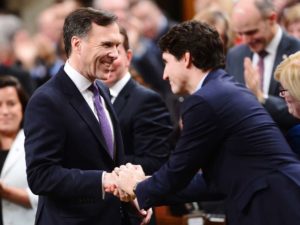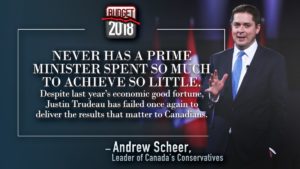 The Liberals’ 2018 federal budget that descended on us on Tuesday afternoon is pretty much what you’d expect from the Justin Trudeau administration at this slightly-past-the-midway point of its mandate: lots of spending on things like gender pay equity, parental leave, native rights. Another stab at sin taxes, with a carton of 200 cigarettes going up by $1 and a proposal for excise duties on cannabis if and when marijuana becomes legal in July. A bit of business tax reform scaled down from the measures that so incensed small business last fall. As for balancing Ottawa’s books? Not so much.
The Liberals’ 2018 federal budget that descended on us on Tuesday afternoon is pretty much what you’d expect from the Justin Trudeau administration at this slightly-past-the-midway point of its mandate: lots of spending on things like gender pay equity, parental leave, native rights. Another stab at sin taxes, with a carton of 200 cigarettes going up by $1 and a proposal for excise duties on cannabis if and when marijuana becomes legal in July. A bit of business tax reform scaled down from the measures that so incensed small business last fall. As for balancing Ottawa’s books? Not so much.
The CBC’s web site provides this overview: Liberals spend billions to close gaps for working women, indigenous families. If you want to do straight to the source, click on the Finance Canada site here.
Here’s the Globe & Mail’s overview that went up soon after 4 pm: Federal budget highlights: 12 things you need to know. In case you’ve met the paywall limit on free views, it reports that the budget is in line with previous estimates from Finance Canada, which means deficits for the “foreseeable future.” Pay equity legislation is proposed for federal government employees and federal regulated sectors. And $447 million will be spent over 5 years to create a new indigenous Skills and Employment Training Program (replacing the Aboriginal Skills and Employment Training Strategy). And another $1.4 billion or more over 6 years is proposed for First Nations child and family services.
A National Pharmacare program is being “consulted” on. More detail on passive income and private corporations: companies with more than $150,000 in passive income will no longer be eligible for the small business tax rate, while those with under $50,000 oil passive income will not be affected. In between is a formula. Also more than half a billion will go to Cybersecurity, and $3.8 billion over 5 years will go to “support science.” And journalism has not been forgotten: the budget proposes $50 million over 5 years to support journalism in “underserved communities.”
At the National Post, this piece looks at 5 ways average Canadians could be impacted by the federal budget. MoneySense‘s Julie Cazzin totes up 15 ways Budget 2015 will impact your wallet. There’s something for everyone, Cazzin writes, but no real showstoppers. Julie also looks at 5 measures that directly impact Canadian families. Another MoneySense writer looks at the implications for small business owners.
Carrick sees 7 changes affecting personal finances
Here’s Rob Carrick’s piece on 7 changes that could affect your finances. Carrick writes in the Globe that Ottawa will be modernizing deposit insurance, replace the Canada Working Income Tax Benefit with the introduction of a Canada Workers Benefit, which raises benefits by up to $170 a year in 2019 for single parents and couples, while raising the level at which the benefit is phase out from $32,339 to $36,483. The Sears bankruptcy appears to have stimulated consultation on pension security, while as of June 2018 an extra five weeks of parental benefits will be available when parents share parental leave. (Yes, Justin Trudeau’s government wishes to encourage more men to take pat leave!) There is also an expansion of the medical expense tax credit and a move to strengthen the oversight of bank sales practices by the federal Financial Consumer Agency of Canada.
Coyne: Budget has nothing to do with budgeting; Ivison: Liberals show their cunning
Back at the National Post, you can get useful video insights from columnists Andrew Coyne, John Ivison and William Watson here. Coyne’s column is titled Liberals deliver a federal budget that has nothing to do with budgeting, or the economy. In it, he wryly observes that the Liberals are pandering “to every conceivable Liberal client group and policy cult: environmentalists, seasonal EI recipients, multiculturalism, official language groups, regional development, all the way to the media … And, of course, feminists.”
John Ivison’s column is headlined “In their third federal budget, Trudeau’s Liberals show their cunning.”
Finally, for a sober look from the tax and accounting pros at KPMG, read this overview.
My take? How about addressing pension inequity between public and private sectors?, not just gender pay inequity?
 And my own take? I wasn’t in the lockup but as per most of the preliminary speculation in the days leading up to this budget, I didn’t have very high expectations to begin with. The moment I saw the budget title of Equality & Growth: A Strong Middle Class, it was clear that investors and business owners would be underwhelmed. Cutting taxes to be more competitive with the juggernaut to the south of us? Dream on! The above quote from Conservative leader Andrew Scheer says it all.
And my own take? I wasn’t in the lockup but as per most of the preliminary speculation in the days leading up to this budget, I didn’t have very high expectations to begin with. The moment I saw the budget title of Equality & Growth: A Strong Middle Class, it was clear that investors and business owners would be underwhelmed. Cutting taxes to be more competitive with the juggernaut to the south of us? Dream on! The above quote from Conservative leader Andrew Scheer says it all.
I suppose we can be grateful that the Tax-free Savings Account wasn’t tampered with and from the early coverage I’ve seen nothing that alters the capital gains inclusion rate. I find it interesting that the Sears pension debacle has the government considering consultation on pension security: while it puts so much focus on gender pay equity there is of course no attempt to redress the massive pension gap between public-sector workers who enjoy inflation-indexed Defined Benefit pensions backstopped by taxpayers and private-sector workers who must make do with RRSPs, TFSAs, taxable savings and all the associated insecurity of relying on financial markets.
We will update this blog periodically over the next few hours, or watch for my Twitter feed (@JonChevreau), which also scrolls to the right of this website.

